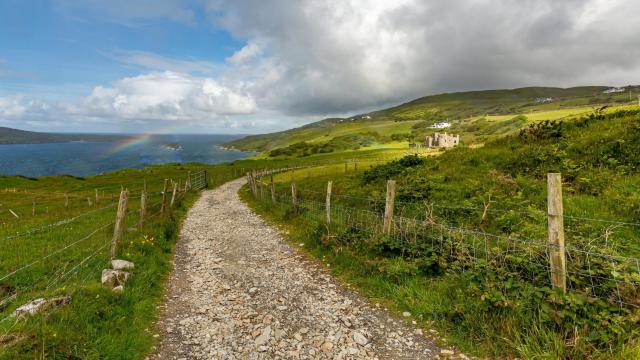Behind every TikTok, Zoom call, and cat meme is a data centre that stores, processes, or reroutes that data around the world. The more we do online, the bigger these data centres and their energy footprint get.
At full capacity, servers within a modern “hyperscale” (aka “massive”) data centre can use as much power as 80,000 households. Although the data centre industry is global, places with the right combination of stable climate and friendly regulations attract outsized attention from data centre developers. Ireland is one of these places. The island nation hosts 70 data centres and is now the fastest-growing data centre market in Europe. Unfortunately, supplying the equivalent of several extra cities worth of electricity to servers that aid your doomscrolling is starting to take a toll on Ireland’s power grid.
Data centres already use around 900 megawatts of electricity in Ireland. According to Paul Deane, an energy researcher working with the MaREI Environmental Research Institute in Ireland, this adds up to at least 11% of Ireland’s total electricity supply at present, a situation he described “as a serious energy systems problem.” As Deane outlined, meeting this demand is making Ireland’s current energy crisis worse and its target of halving greenhouse emissions by 2030 harder to reach. And things are only getting more challenging. A recent report from Eirgrid, Ireland’s state-owned grid operator, shows that data centres will consume almost 30% of Ireland’s annual electricity supply by 2029.
Although, as Deane pointed out, data centres are essential to modern life (the Zoom call I have with him wouldn’t be possible without them), a small country with little grid power to spare hosting so many of them puts the sustainability of Ireland’s entire power supply at risk. Deane summed up Ireland’s issue with data centres as being a mismatch in size. “Data centres are large power users, and our power system is small, so plugging more of them into a small grid will start to have an outsized impact,” he said. In stark comparison, Germany, the EU’s biggest data centre market overall, will use less than 5% of its grid capacity to power data centres in the same period. As well as stoking fears that the industry’s growth will create blackouts and power shortages for Irish consumers this winter, data centres may also derail Ireland’s drive to reach net zero emissions by 2050.
For Phoebe Duvall, planning officer at An Taisce, a leading Irish environmental NGO, this is the data centre industry’s core problem. “As we see it, Ireland is hosting a disproportionate amount of data centres, something which has enormous climate implications,” she said.
An Taisce, which as a prescribed planning body (an organisation with legal supervisory duty somewhat unique to the country), must receive notice of plans or developments that might impact Ireland’s natural environment, has objected to several data centre developments so far. Duvall said that the NGO’s core concern is that more than doubling the size of Ireland’s data centre industry by 2030 is directly at odds with Ireland’s otherwise progressive climate action goals.
“Yes, they [data centres] are supporting renewables, but we cannot have all our renewables going towards new developments instead of decarbonizing our existing energy system,” she said.
Host In Ireland, a data centre developer representative body, portrays the industry as a climate champion. It often highlights how data centre owners make power purchase agreements with renewable energy developers. A press release from the group boasts that the growth of the Irish data centre industry will “go hand-in-hand with the development of green electricity to meet power availability demands.” However, according to Deane, this is not the whole story. He said that unless data centres can somehow store renewable energy onsite or flexibly share computing demand globally (to get renewable energy 24/7), more data centres will result in more fossil fuel power plants. “They are not going to just turn off Facebook because it’s dark or it’s not windy outside,” he added.
As far as An Taisce sees it, this industry disconnect with real climate policy makes data centre growth in Ireland reckless. The organisation has lent its support to calls by politicians outside of Ireland’s centre-right governing coalition, such as Social Democrat TD (elected representative) Jennifer Whitmore, for a moratorium on data centre construction. Until their climate and energy impact is better understood and measures can be put in place to encourage sustainability, groups like An Taisce want to see data centre construction paused. Singapore recently took a similar step due to land and energy use concerns.
With its new climate action plan stating an intent to “review” current policy on data centre construction, Ireland’s traditionally data centre-friendly government may yet take some steps in this direction. Recently published guidelines from Ireland’s utility regulator now require new data centre grid connections to be “within the system stability and reliability needs of the electricity network,” a move that may discourage development. However, although the government’s belated recognition of the need for action on data centres is welcome, the industry itself also needs to do more. Data centre developers have been quick to explain why they have come to Ireland in the first place, but, as Deane put it, “now they need to show us why they should stay.”
Robbie Galvin is a writer based in Ireland. Reporting on topics ranging from sustainability to edible seaweed, he has written for publications such as Hakai Magazine, Earth Island Journal, and Whetstone Magazine.
